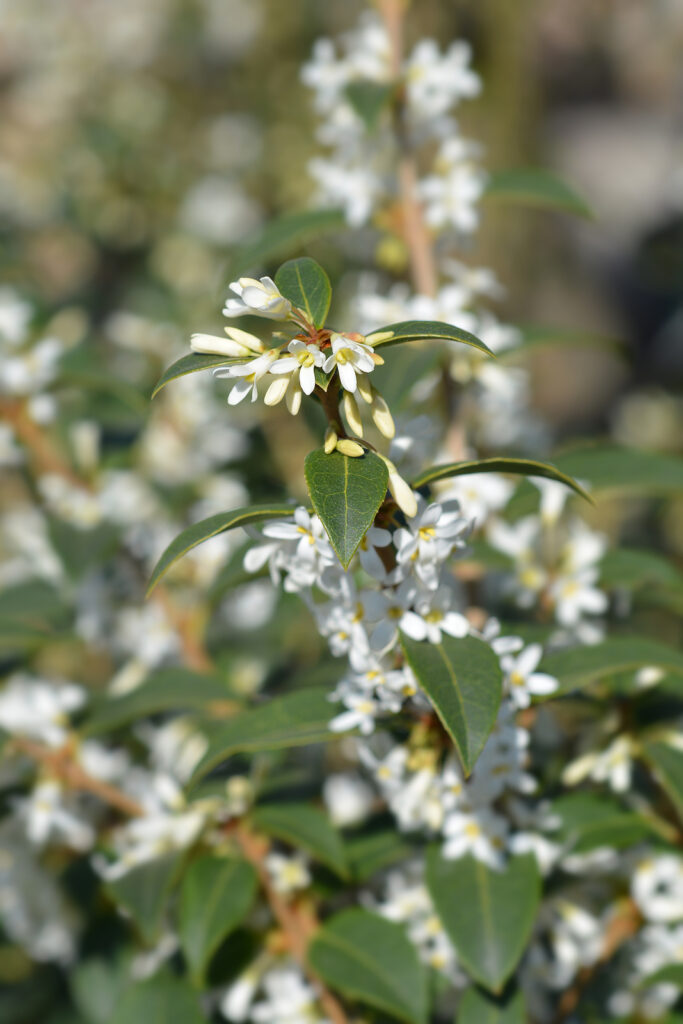Osmanthus–commonly called Sweet olive–bears tiny white flowers that are intensely fragrant. Plant sweet olive near a window or patio where its peachy-apricot fragrance can be enjoyed. It is ideal for hedges and screens, or along walks and entryways where its fragrance can be appreciated.
Osmanthus is grown for its foliage and flowers. Leaves are lance-shaped to ovate and borne in pairs. Flowers are small and tubular with four lobes; they are usually fragrant, white, occasionally yellow or orange.
Osmanthus is a warm-region evergreen that can be grown as a shrub or trained as a small specimen tree. Young sweet olives can be potted and grown indoors in winter for their fragrance.
Osmanthus is a genus of 15 to 20 species of evergreen shrubs and small trees. Osmanthus is native to the Southern United States and the Pacific Islands and Asia.
Get to know Osmanthus
- Plant type: Broadleaf evergreen shrub or tree
- Growing Zones and range: 8-9
- Hardiness: Grows best in cool conditions between 40°and 65°F (4.5°-15°C)
- Height and width: Commonly grows 6 to 10 feet (1.8-3m) tall, can reach 25 feet (7.6m) tall and wide
- Foliage: Leathery, dark green, elliptical leaves are finely toothed
- Flowers: Clusters of small white fragrant flowers
- Bloom time: Most of the year, most abundant in spring and fall
- Uses: Plant in shrub border or as small specimen tree
- Common name: Sweet Olive
- Botanical name: Osmanthus fragrans
- Family: Oleaceae
- Origin: Southern United States, Pacific Islands and Asia

Where to plant Osmanthus
- Plant Osmanthus in full sun or partial shade; plant in afternoon shade in hottest climates.
- Osmanythus grows in most garden soils from acidic to alkaline; grow in containers in soil-based container mix amended with leaf mold or compost.
When to plant Osmanthus
- Plant Osmanthus in spring after the last frost.
Planting and spacing Osmanthus
- Space Osmanthus plants 6 feet (1.8m) apart
How to water and feed Osmanthus
- Keep the soil evenly moist.
- Fertilize Osmanthus monthly with an all-purpose fertilizer.
Osmanthus care
- Pinch growth tips on young plants to encourage bushiness.
- Repot container-grown plants every other year in spring.
- Prune in spring after bloom.
- Put potted plants outdoors in summer.
Osmanthus pests and diseases
- Osmanthus is susceptible to black mildew, anthracnose, olive know, Verticillium wilt and root rot.
- Osmanthus can be attached by scale insect.
Osmanthus propagation
- Take stem cuttings, set them in sand, and keep the humidity very high for good rooting.
Osmanthus varieties to grow
- Osmanthus fragrans aurantiacus has orange flowers.
- O. burkwoodii slow growing from 6 to 10 feet tall and 8 to 12 feet wide; glossy bright green, tooth edged leaves; use in hedges.















